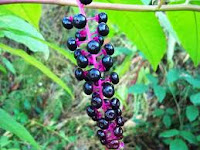EUROPEAN OR COMMON PAEONY, PAEONIA OFFICINALIS
The European paeony is native to mainland Europe , with its range extending from France Albania Greece
In Britain island of Steep Holme Severn , close to the Bristol Channel , (interestingly there were none on the neighbouring island of Flat Holme
I grew up with paeonies in the garden and the plants we had were very old, and I know now that these bushy plants are renowned for their longevity. I loved their smell and colour and often tried to capture their beauty in drawings and paintings without much success. You can dry the petals and use them in tisanes which are good for colds, and the flowers can also be cooked and eaten as a vegetable I’m told (as can flowers from the kachnar tree Bauhinia variegata).
 The name paeony is said to have come from the name (Paeos) of a student of the Greek physician Asclepius. This acolyte of the great physician earned his jealous wrath when he cured the god of Hades of his wounds which he had received during the Trojan Wars. He was turned into the plant that now bears his name to escape death at the hands of Asclepius according to one myth. Another is that he cured the gods of
The name paeony is said to have come from the name (Paeos) of a student of the Greek physician Asclepius. This acolyte of the great physician earned his jealous wrath when he cured the god of Hades of his wounds which he had received during the Trojan Wars. He was turned into the plant that now bears his name to escape death at the hands of Asclepius according to one myth. Another is that he cured the gods of  This wild paeony was cultivated by Benedictine monks in their monastery gardens in the Middle Ages and from these it became common in cottage gardens. John Gerard, writing in the 16th century, recommends paeony seeds as a way to prevent nightmare and melancholic dreams. The flowers and seeds especially were thought to have the ability to ward off evil, and the seeds were threaded sometimes to make necklaces for this purpose.
This wild paeony was cultivated by Benedictine monks in their monastery gardens in the Middle Ages and from these it became common in cottage gardens. John Gerard, writing in the 16th century, recommends paeony seeds as a way to prevent nightmare and melancholic dreams. The flowers and seeds especially were thought to have the ability to ward off evil, and the seeds were threaded sometimes to make necklaces for this purpose. The paeony has a few superstitions surrounding it and it was thought unlucky to dig up the roots, which was unfortunate as these have medicinal properties as well as the seeds.
 Pliny the Elder, probably relating a tale told by Theophrastus (c.327-287BC), relates this piece of cautionary information: you should dig the paeony root up only at night because if you are seen doing so by the woodpecker it will peck out your eyes.
Pliny the Elder, probably relating a tale told by Theophrastus (c.327-287BC), relates this piece of cautionary information: you should dig the paeony root up only at night because if you are seen doing so by the woodpecker it will peck out your eyes. The seeds can be dry roasted and used as a condiment if ground when still warm and added to soups and stews as a spice. The root should be harvested in autumn and dried thoroughly in the sun for later use. It has antispasmodic properties and has been made into suppositories for intestinal and anal spasms. During the Middle Ages the root was dried, powdered and used to treat epilepsy and lunacy as well as to promote menstruation. No preparations of paeony should be taken during pregnancy.
The tisane or infusion made from the dried crushed petals can be used as a lotion for varicose veins and piles and taken internally is good for coughs. One ounce of crushed petals to one pint of boiling water drunk in small cupfuls can be taken three times a day.
 In Christian symbolism, again in the Middle Ages, paeonies represented feminine beauty, wealth and healing powers. In medicine during those times the seeds were used in medicines to disperse blockages in the internal organs, especially to get rid of bladder stones, as they have diuretic qualities, for jaundice, stomach pains, diarrhoea and labour pains.
In Christian symbolism, again in the Middle Ages, paeonies represented feminine beauty, wealth and healing powers. In medicine during those times the seeds were used in medicines to disperse blockages in the internal organs, especially to get rid of bladder stones, as they have diuretic qualities, for jaundice, stomach pains, diarrhoea and labour pains. This paeony is no longer used in medicine except in some homeopathic remedies.




































